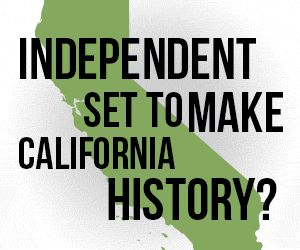Independents Aren’t Spoilers Anymore: Another Look at California’s Top-Two Primary

SAN DIEGO, CALIF. - It is nearly impossible for a candidate to run, and win, as an independent in most states. Without a party infrastructure, candidates have little to no support structure, including party member communications, party campaign finance advantages, and perhaps most importantly, the benefit of an almost universally accepted axiom: only a Republican or a Democrat can actually win.
As a result, independent and third-party candidates are most-often marginalized as “spoilers,” “quixotic,” and “fringe,” even when they enjoy high approval ratings.
ALSO READ: The Two-Party Duopoly Just Forced Out America’s Only Independent Governor
This is the consequence of a system that has insulated the two major parties from serious competition for over 100 years.
California voters, however, took a seemingly small chip away from the two-party establishment in 2010 when they voted for a nonpartisan top-two primary.
In a traditional partisan primary, candidates are nominated by their party’s voters to be placed on the general election ballot. Over time, it is natural and predictable this party-centric nomination process will produce more party-centric candidates.
And when less partisan voters leave their political party, like they are doing in California, the partisanship that results from such a nomination process gets more and more magnified.
By the time the general election rolls around, a johnny-come-lately independent or third-party candidates has little time, few resources, and no institutional support to mount a serious challenge to the party-nominated candidates and the two-party public narrative they’ve already had a chance to frame.
In a nonpartisan primary, however, the rules of the election game are fundamentally different. In a nonpartisan race, every candidate and every voter participate on the same ballot. There are no advantages or disadvantages for any voter or candidate based on their party affiliation or non-affiliation.
Democrats might refer to this as “equality.” Republicans as “fair competition.”
But however one refers to a “top-two” nonpartisan primary, the voter-centric nomination process produces two candidates, regardless of party, that must then compete head-to-head for the votes of everyone.
ALSO READ: California: Partisan Insiders Frustrated by UNRIGGED Top-Two Primary
When there are only two candidates, credible independents cannot be characterized as “spoilers,” and the two-party system can actually make them more viable, despite an independent candidate’s lack of institutional support.
Take “No Party Preference” candidate Steve Poizner, who is running for state insurance commissioner. He advanced to the November general election through the nonpartisan primary and has only one opponent: a respected, far-left Democrat, Ricardo Lara.
Having previously served as California’s insurance commissioner, Steve Poizner commands a high-level of credibility. Therefore, he cannot be ignored by the media, the pollsters, or be cast aside as a spoiler.
So, without a Republican on the ballot, who are Republicans likely to vote for?
Without feeling like they might waste their vote on a “spoiler” candidate, who are independents likely to vote for?
And don’t forget the sizable number of Democrats that may not be so excited about their own party’s level of partisanship.
That could be why Steve Poizner maintains a sizable lead in most statewide public opinion polls just weeks before Election Day, despite California’s massive Democratic voter registration advantage.
But don’t underestimate the power of the party political machines. They know how to get voters to the polls, and they have millions of dollars, hundreds of candidates, and thousands of volunteers to help them do it.
If Steve Poizner wins, without his own party machine, he will become the talk of the political class across the country.
Poizner will deserve a lot of the credit. He’s a qualified candidate with enough resources to mount a serious campaign.
But don’t underestimate the power of the nonpartisan top-two primary.
Without it, he’d be just one party’s spoiler.
 Chad Peace
Chad Peace





